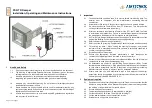
Page 1 of 11 pages
1
Health and Safety
1.1
Only competent personnel may carry out the work outlined within this document.
1.2
The wearing of appropriate Personal Protective Equipment (gloves, footwear,
safety glasses etc.) is required for safe working and as the site dictates.
Dampers may be heavy. Large dampers will require suitable lifting and
supporting equipment, with due consideration given for manual handling.
1.
4
Dampers may close without warning. Do not introduce limbs/fingers between
blades whilst the actuator is fitted.
1.5
Where dampers are only accessible with the need for additional elevation, any
equipment used should be done so with due consideration to the Work at Height
regulations 2005 and current site rules.
1.6
All work should be carried out in accordance with HSE guidelines and regulations
and any specific local site rules.
2
Important
2.1
These instructions should be read in its entirety before commencing work. The
installer must be Competent with the manufacturer’s separating element
construction.
2.2
Actuators are IP54 rated
– Check actuator connection box is suitably located.
2.3
Do not cut/shorten the Thermal Fuse lead (-TF Actuators). This will render the
unit inoperable and invalidate the warranty.
2.4
Where an actuator is supplied with a Thermal Fuse (TF), the TF MUST be fitted
in accordance with instructions. Failure to meet this requirement will invalidate
the warranty and the damper will fail to respond as designed/tested.
2.5
All Fire / Smoke Damper installations must be carried out to the satisfaction of the
appropriate Building Control officer and/or specifying authority.
2.6
Refer to actuator label for wiring of actuator.
2.7
Refer to section 20 for testing. Complete Insp Check List (at end of this document)
2.8
For existing dry walls
– When cutting the opening for damper, and (partial)
removal of stud is unavoidable, ensure the structure is sufficiently supported to
conform to design specification
2.9
Dry wall openings must be lined.
2.10
Ensure that appro
priate ‘fire-rated’ plasterboard is used throughout the
construction of drywall partitions that need to act as fire-barriers.
2.11
Ductwork to be fitted and connected in accordance with DW 144/145. Aluminium
rivets should be used (to act as breakaway joint).
2.12
All installations are subject to local Building Control Approval (BCA). Tested
Installations are detailed herein. If the proposed installation has minor variations
to that shown, acceptance from BCA should be sought before proceeding.
Manufacturers are not able to ‘approve’ specific installation methods
2.13
Where more than one duct penetrates a wall or floor, adjacent fire damper
assemblies should be separated by a structural element with a minimum width of
200mm (to comply with BS EN1366-2 13.6).
3
Equipment required
3.1
Equipment and tools will vary dependent upon the fire barrier construction that the
damper is being installed within. Standard equipment that are normally used for
the building of the particular barrier should suffice.
3.2
Access-equipment as necessary.
3.3
Temporary support equipment (to retain damper in position).
3.4
Cordless drill with 2,5mm and 10mm drill bits for fitting TF.
3.5
Phillips
№2 screwdriver to suit thermal fuse screws
3.6
Screwdriver to suit junction box terminals.
FSD-TD Damper
Installation, Operating and Maintenance Instructions
1.
3














